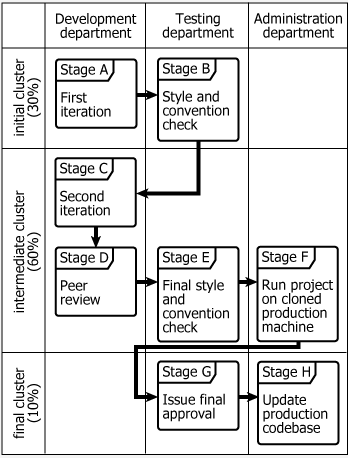At a certain company, successful projects proceed through 8
stages-Stages A through H. An active project is one that is currently in
one of these 8 stages. If a stage of a project is completed during a
given day, the project is immediately moved to the next stage. At the
end of each day, the current stage of each active project is recorded.
Some stages require as little as 1 day of work, and none requires more
than 3 days of work. A project is said to be delayed if it spends more
time at a stage than is required to complete the work. If a project is
canceled, the current stage for the day is recorded as Stage X, and the
project is no longer considered an active project.
For any given project, the diagram shows the progression of the stages
of the project as well as the department of the individuals responsible
for each stage. The stages-divided into the initial, intermediate, and
final clusters-are each assumed to constitute some nominal fixed
percentage (NFP) of the project's lifetime. In the diagram, each cluster
percentage is the sum of the NFPs for the stages within the cluster.

A status history report-a report containing the daily project status for any project that was active within a given timeframe-is produced by a computer program. Below is the report that was generated at the end of the day today, which is the fifth day of Week 7. The report shows, for example, that Project 75039 began on the second day of Week 6, spent 3 days each in Stages A and B, and has been in its current stage, Stage C, for 3 days.

 mofa留学圈
mofa留学圈







 做题笔记
做题笔记
 暂无做题笔记
暂无做题笔记 提交我的解析
提交我的解析


